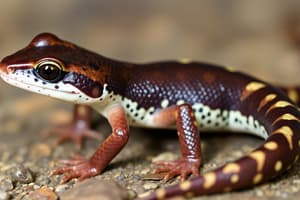Podcast
Questions and Answers
What chapter discusses the extinction of amphibians, particularly the Panamanian Golden Frog?
What chapter discusses the extinction of amphibians, particularly the Panamanian Golden Frog?
Chapter 1: The Sixth Extinction
What fungus was identified as a reason for the extinction of the Golden Frog?
What fungus was identified as a reason for the extinction of the Golden Frog?
- Mold
- Chytrid Fungi (correct)
- Wet Rot
- Bacterial Infection
Georgie Cuvier believed that Mastodons should never have gone extinct.
Georgie Cuvier believed that Mastodons should never have gone extinct.
True (A)
What specifically did Kolbert use the Great Auk to symbolize?
What specifically did Kolbert use the Great Auk to symbolize?
What was a main cause of the Cretaceous-Paleogene extinction according to Kolbert?
What was a main cause of the Cretaceous-Paleogene extinction according to Kolbert?
What mechanism for extinction is associated with glaciation according to Kolbert?
What mechanism for extinction is associated with glaciation according to Kolbert?
The increase of carbon dioxide is beneficial for marine life.
The increase of carbon dioxide is beneficial for marine life.
What does Kolbert warn about in relation to ocean acidification?
What does Kolbert warn about in relation to ocean acidification?
What does Kolbert suggest is a significant factor in a species' survival or extinction?
What does Kolbert suggest is a significant factor in a species' survival or extinction?
Habitat fragmentation is beneficial for species survival.
Habitat fragmentation is beneficial for species survival.
What did Kolbert argue about Neanderthals and modern humans?
What did Kolbert argue about Neanderthals and modern humans?
What efforts does Kolbert conclude the book with?
What efforts does Kolbert conclude the book with?
Flashcards are hidden until you start studying
Study Notes
The Sixth Extinction Overview
- Emphasizes ongoing species extinctions primarily driven by human activity and environmental changes.
- Each chapter explores different extinction mechanisms through historical examples and case studies.
Chapter 1: The Sixth Extinction
- 300 million years of amphibian existence undermined by recent drastic declines.
- The Panamanian Golden Frog is critically endangered due to Chytrid Fungi, an invasive species linked to human movement.
- The frog-fungus scenario illustrates the broader issue of invasive species disrupting ecosystems.
Chapter 2: The Mastodon's Molars
- Fossils of the American Mastodon influenced Georges Cuvier's catastrophism theory, positing sudden natural disasters as extinction causes.
- Cuvier believed the Mastodon should have survived based on its physical adaptations.
- Highlights the idea that catastrophes can lead to significant extinction events.
Chapter 3: The Original Penguin
- The Great Auk, once plentiful, succumbed to human exploitation for food and resources.
- By 1844, the bird had become extinct, exemplifying the impact of overexploitation on species survival.
Chapter 4: Luck of the Ammonites
- The Cretaceous-Paleogene extinction was largely due to environmental changes from asteroid impact dust.
- Ammonites, though well-adapted, went extinct due to changes that shifted survival advantages.
Chapter 5: Welcome to the Anthropocene
- Explores glaciation impacts on graptolites and others, altering ocean chemistry and leading to extinction.
- High carbon dioxide levels correlate with increased temperatures and rising sea levels exacerbated by human actions.
Chapter 6: The Sea Around Us
- Post-Industrial Revolution carbon dioxide emissions have raised atmospheric levels significantly.
- Ocean acidification threatens marine biodiversity due to lowered ocean pH levels, risking mass extinction.
Chapter 7: Dropping Acid
- Coral reefs support diverse marine life but face extinction risks from ocean acidification, with possible consequences by century's end.
Chapter 8: The Forest and the Trees
- Global warming and polar ice melt threaten species reliant on cold environments for survival.
- Species mobility and adaptability are crucial for coping with climate impacts.
Chapter 9: Islands on Dry Land
- Environmental fragmentation reduces species diversity; small habitats can’t sustain stable populations.
- Specialized habitats make certain species vulnerable to ecological disruptions.
Chapter 10: The New Pangaea
- An evolutionary arms race among species driven by new predators, pests, and diseases, often linked to global trade.
- The American Chestnut Tree’s decline due to imported fungal disease exemplifies the risks of species redistribution.
Chapter 11: The Rhino Gets an Ultrasound
- Deforestation has fragmented habitats, leading to steep declines in the Sumatran Rhino population, down to a few hundred by the 1900s.
Chapter 12: The Madness Gene
- Neanderthals existed in Europe for 100,000 years but vanished approximately 30,000 years ago after modern humans arrived.
- Breeding between modern humans and Neanderthals contributed to the latter's extinction, showing human impact on ancestral species.
Chapter 13: The Things with Feathers
- Concludes with a message of hope, focusing on conservation efforts to protect endangered species.
- Highlights humanity's critical role in determining the future of evolutionary paths and species survival.
Studying That Suits You
Use AI to generate personalized quizzes and flashcards to suit your learning preferences.




